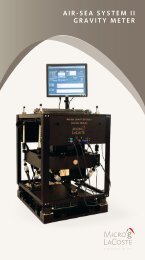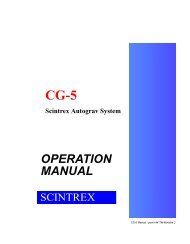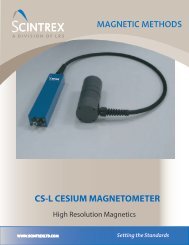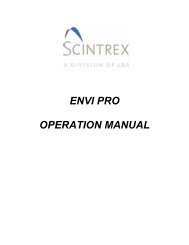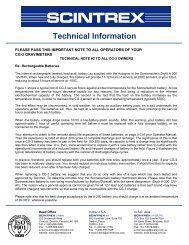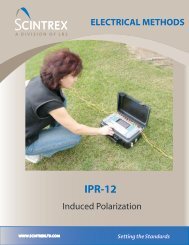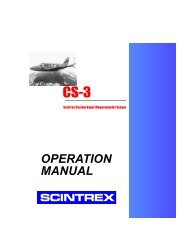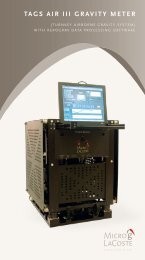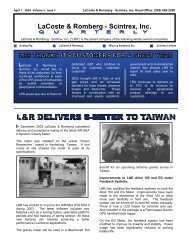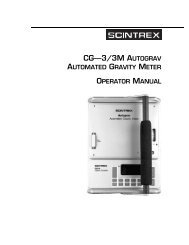CS-L Cesium Vapor Magnetometer Sensor OPERATION ... - Scintrex
CS-L Cesium Vapor Magnetometer Sensor OPERATION ... - Scintrex
CS-L Cesium Vapor Magnetometer Sensor OPERATION ... - Scintrex
You also want an ePaper? Increase the reach of your titles
YUMPU automatically turns print PDFs into web optimized ePapers that Google loves.
Orienting<br />
Several times during a survey day, a tie line may be used. The tie line is generally<br />
flown at 90° to the survey line, which would be in our example either in the NE or SW<br />
direction. The magnetometer sensor orientation must be selected so that it performs<br />
well on the direction parallel or antiparallel to the survey line, and parallel or<br />
antiparallel to the tie line, which is perpendicular to the survey line.<br />
Calculating the Tumble Angle<br />
<strong>CS</strong>-L sensor orientation is determined by two angles:<br />
• the sensor azimuth, a, defined as the angle in the horizontal plane between<br />
the horizontal projection of the sensor optical axis direction and the direction<br />
of the magnetic north<br />
• the magnetometer sensor inclination, b, defined as the angle in the vertical<br />
plane between the horizontal line and the magnetometer optical axis.<br />
• The ambient magnetic field inclination, g, is defined as the angle between the<br />
horizontal and the field direction. The Earth's magnetic field inclination is a<br />
positive angle in the range from 0° to 90° in the Earth's Northern Magnetic<br />
Hemisphere and negative in the Southern Hemisphere.<br />
For a given sensor orientation and magnetic field inclination, the angle<br />
between the sensor and the magnetic field, i.e. the tumble angle, q, can be<br />
calculated from the following equation:<br />
q = arccos(cosa x cosb x cosg + sinb x sing ) (3)<br />
This equation can be used to find out whether the magnetometer sensor is<br />
inside its active zones specified by equations (1) and (2). It is a good idea to<br />
reduce the operating active zone by the amount of the anticipated aircraft<br />
motion. In general, airborne magnetic surveys are conducted in calmer<br />
weather to keep the aircraft motion to within 5° in pitch, roll and yaw.<br />
In this case, with the additional allowance we must orient the magnetometer sensor<br />
so that the tumble angle, q, satisfies in the northern operating hemisphere the<br />
relationship:<br />
15° > q > 80° (4)<br />
and in the southern operating hemisphere the relationship<br />
100° > q > 165° (5)<br />
Inside this operating zone the magnetometer noise will increase by about a factor of<br />
two from the minimum value at q=40° or q=140°, and the heading error will be inside<br />
the specified limits of +/-0.25nT.<br />
As it will be seen in the next section, orienting the <strong>CS</strong>-L is simple: with only two<br />
settings one can survey the entire Earth's surface. However, in order to gain more<br />
insight, the tumble angle, equation (3), is evaluated, over the entire range of the<br />
magnetic field inclinations, for two sets of sensor azimuths, and five values of sensor<br />
inclinations.<br />
Tumble angles from 0° to 90° indicate that the magnetometer has to be set for<br />
operation in the northern operating hemisphere. Tumble angles from 90° to<br />
180° indicate that the magnetometer has to be set for operation in the<br />
4—7<br />
P/N 763701 Rev. 1



